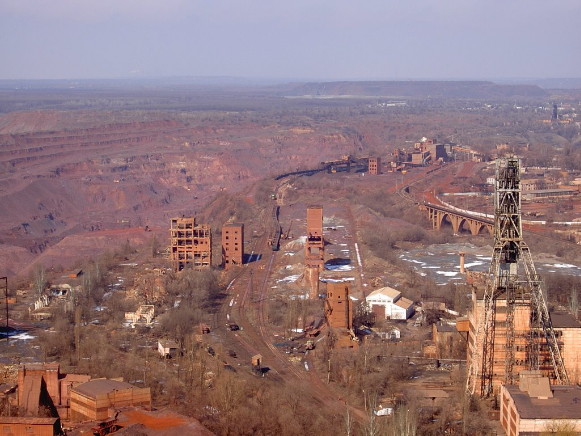Kryvyi Rih Iron-ore Basin
Kryvyi Rih Iron-ore Basin (Криворізький залізорудний басейн; Kryvorizkyi zalizorudnyj basein). The most important Ukrainian iron-ore–producing region and the largest single source of iron in the former USSR. A narrow strip about 100 km long and 2–7 km wide, extending through western Dnipropetrovsk oblast from the town of Zhovti Vody in the north to Inhulets in the south, the basin covers an area of approximately 300 sq km. The city of Kryvyi Rih is the major industrial center in the region.
The Kryvyi Rih Basin contains mostly Precambrian sedimentary-metamorphic rocks and is divided into three suites. The middle suite, with a thickness of up to 2,000 m, is the main ore-bearing formation. It consists of seven to eight seams of ferruginous quartzites (represented by hematites, magnetites, and mixed hematite-magnetite varieties) and schists. The average iron content is 30–40 percent in the ferruginous quartzites and 25–30 percent in the magnetite varieties (which compose 20 percent of the total quartzite reserves). Rich iron-ore bodies are dispersed throughout the ore-bearing formation. The ore is formed in columnar, lenticular, and pocket-like bodies that descend to a depth of over 1,000 m. In several places the bodies merge into large sloping ore beds. The rich ores are divided into magnetite, martite, and hematite-martite ores. The last two varieties have an average iron content of 63.7 percent and make up more than half of all reserves.
The Kryvyi Rih Basin has been excavated for iron ore since the time of the Scythians, but detailed prospecting and commercial exploitation began only in the second half of the 19th century. In 1881 Oleksander Pol founded a joint-stock company with French capital to develop mining in the basin. In its first year the company mined 37,400 tonnes of iron ore. Production rose rapidly when a railway was constructed in 1884 connecting Kryvyi Rih with the coal-producing region of the Donets Basin. By 1913 the Kryvyi Rih Basin provided 6.4 million tonnes, or 74.5 percent of all the iron ore produced in the Russian Empire. Fifty-one mines had been sunk and 23,600 miners worked in the region, making the area one of the largest industrial centers in Ukraine.
During the Revolution of 1917 and the subsequent struggle for independence (1917–20), many of the mines and machines were destroyed and production fell drastically. The prewar level of production was not reached again until 1931. However, efficiency was greatly disrupted by the forced rate of industrialization, and more workers (77,339 in 1932) were needed to reach the same level of output.
In 1940, production reached 18.9 million tonnes, or 63 percent of the Soviet total. After the Second World War the mines were increasingly mechanized and the problems of beneficiating ferruginous quartzites were overcome. The basin produced 80 million tonnes, or 52 percent of Soviet production, in 1965 and 58 percent of total Soviet output in 1972. Subsequently, however, its proportion of Soviet production declined as the rich deposits in the Kryvyi Rih region had been exhausted and new sources had been developed. In 1984 the basin accounted for 46 percent of all Soviet production, although total output increased to 103 million tonnes.
Annual production consisted of 38 million tonnes of deep-mined ore excavated from 23 mines extending down to 1,200 m. Another 65 million tonnes were mined from 11 open pits. The rich iron-ore bodies were becoming depleted and reserves (1.5 billion tonnes in 1968) were expected to last only another 25–35 years. The lower-grade quartzite ores that are mined in open pits are becoming increasingly important and are beneficiated in five large complexes, including the Southern Mineral Enrichment Complex and the New Kryvyi Rih Mineral Enrichment Complex. A sixth concentrator was built jointly by the Comecon countries. This reflected the importance of Ukrainian iron ore for the east-European countries, which imported one-quarter of Ukraine’s production. The new concentrator reprocesses inferior-grade quartzites that were discarded as tailings and has an annual capacity of 14 million tonnes. Total industrial reserves in the basin are estimated at 16 billion tonnes (1979) and are expected to last several hundred years.
The Kryvyi Rih Basin, producing 85 percent of total Ukrainian output, supplies iron ore to several metallurgical plants in the Dnipro Industrial Region and the Donets Basin. The extractive industry employs 62.5 percent of the work force in the city of Kryvyi Rih and 93 percent in the towns of Zhovti Vody and Inhulets.
Bohdan Somchynsky
[This article originally appeared in the Encyclopedia of Ukraine, vol. 2 (1988).]


.jpg)